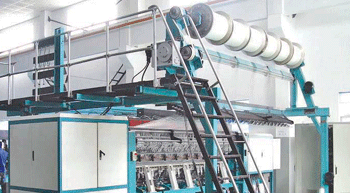
Karl mayer gives boost to spacer textiles
The RD 7/2-12 EN and the RDJ 5/1 was presented to a wider group of specialists, invited by KARL MAYER (China), to an open-house event recently.
The RD 7/2-12 EN and the RDJ 5/1 was presented to a wider group of specialists, invited by KARL MAYER (China), to an open-house event recently.
Warp-knitted spacer textiles are continuing to make headway. Breathable, tough and stylish, they are increasingly taking over from flat fabrics in the shoe fabric sector, but these functional spacer textiles have also become an integral part of mattresses. They are ideal for use in the ventilation zones in the side borders, as soft covers, or as functional partners in multilayered foam constructions. Clothing manufacturers have also discovered the advantages of warp-knitted spacer textiles. The technical features of 3D fabrics in outdoor clothing provide an extravagant look, climatic comfort and new, haptic experiences.
This trend towards warp-knitted spacer textiles has been spurred on by the availability of a wide range of products at competitive prices, which are produced on flexible and efficient machines. 3D warp-knitted textiles are produced on double-bar raschel machines. The machines produced by KARL MAYER, the world leader in this field, are extremely innovative. This innovative company will launch two new machines onto the market in spring 2015. These are the RDJ 5/1, with which the company is following its twin product line strategy in the double-bar raschel machine sector, and the RD 7/2-12 EN, on which patterning based on chain links has been replaced by a system offering greater speed and flexibility.
The RD 7/2-12 EN and the RDJ 5/1 was presented to a wider group of specialists, invited by KARL MAYER (China) Ltd., to an open-house event on 22 and 23 January 2015.
RDJ 5/1
Warp-knitted spacer textiles patterned with jacquard designs are products showing a real growth potential. Shoe manufacturers in particular are becoming increasingly interested in spacer fabrics with their wide range of different designs. They are creating a demand that has led to textile producers investing continuously in new, innovative production machinery, especially in Taiwan, Korea and China, the main manufacturing countries. As a result of this expansion and renewal of capital, KARL MAYER´s RDPJ 7/1 has become firmly established as an efficient, flexible machine. This tried-and-tested, high-tech model now has a sister machine in the basic machine segment. This new machine is known as the RDJ 5/1 and is continuing KARL MAYER´s twin product line strategy for its RD machine series. It offers manufacturers of warp-knitted spacer textiles competitive advantages in a variety of applications, but its cost:benefit ratio was designed especially to meet the requirements of the shoe fabric market in China. With two guide bars fewer than the RDPJ 7/1, the RDJ 5/1 offers adequate patterning possibilities for designing shoes and a high level of efficiency at the same time. The configuration and features of the machines are also different. Whereas the RDPJ 7/1 can either be supplied with N or EL guide bar control, the RDJ 5/1 is available with N pattern drive only. The width and distance between the trick plates on both machines are the same and the available gauges typical of the machines. The RDJ 5/1 is available in gauges E 22 and E 24 and the RDPJ 7/1 EL is available in gauges E 24 and E 28. Delivery of the first new machine is scheduled for spring 2015.
RD 7/2-12
The RD 7/2-12 offers maximum design possibilities and can therefore produce a wide range of different products. With this specific feature, this sturdy, all-round machine is mainly used by shoe fabric manufacturers operating the N drive version. Complex designs are frequently not worked with pattern discs but with pattern chains, which involves a loss of productivity. There is now an alternative to this, i.e., a new electronic guide bar drive offering the flexibility of pattern discs and chains at a lower cost than the conventional EL pattern drive.
The basic EL pattern drive, wit




